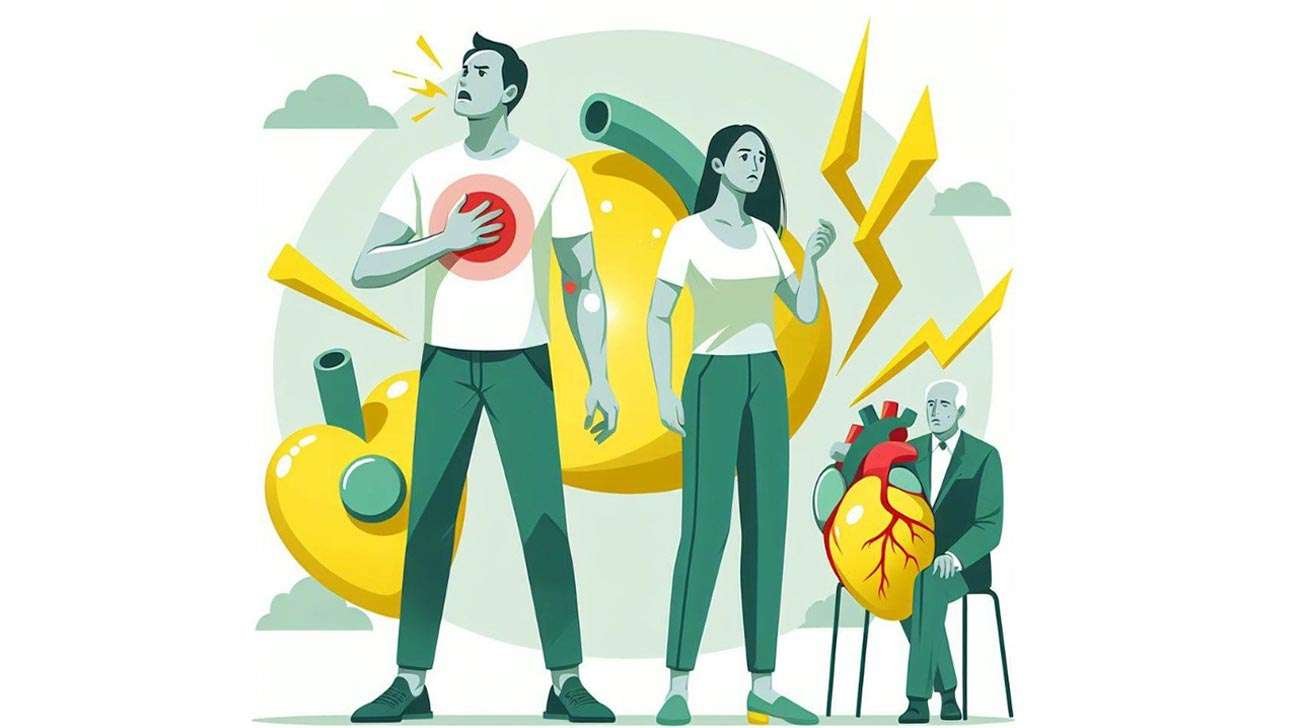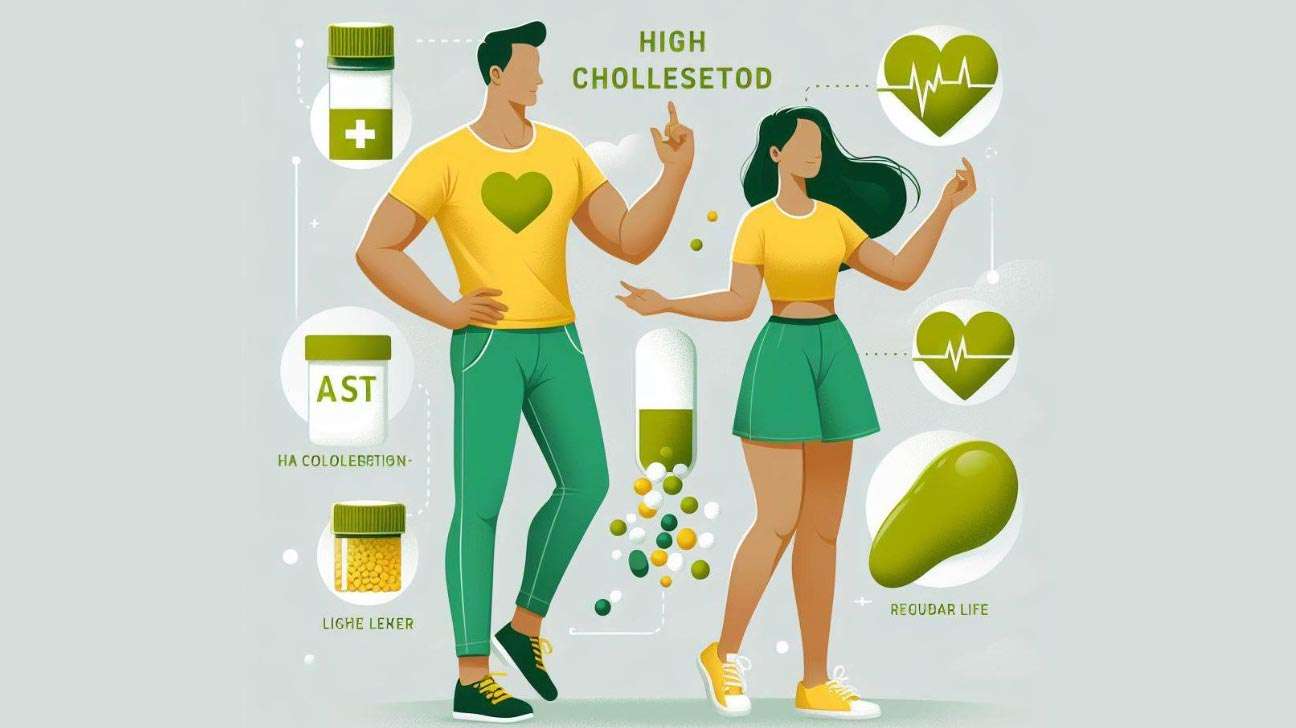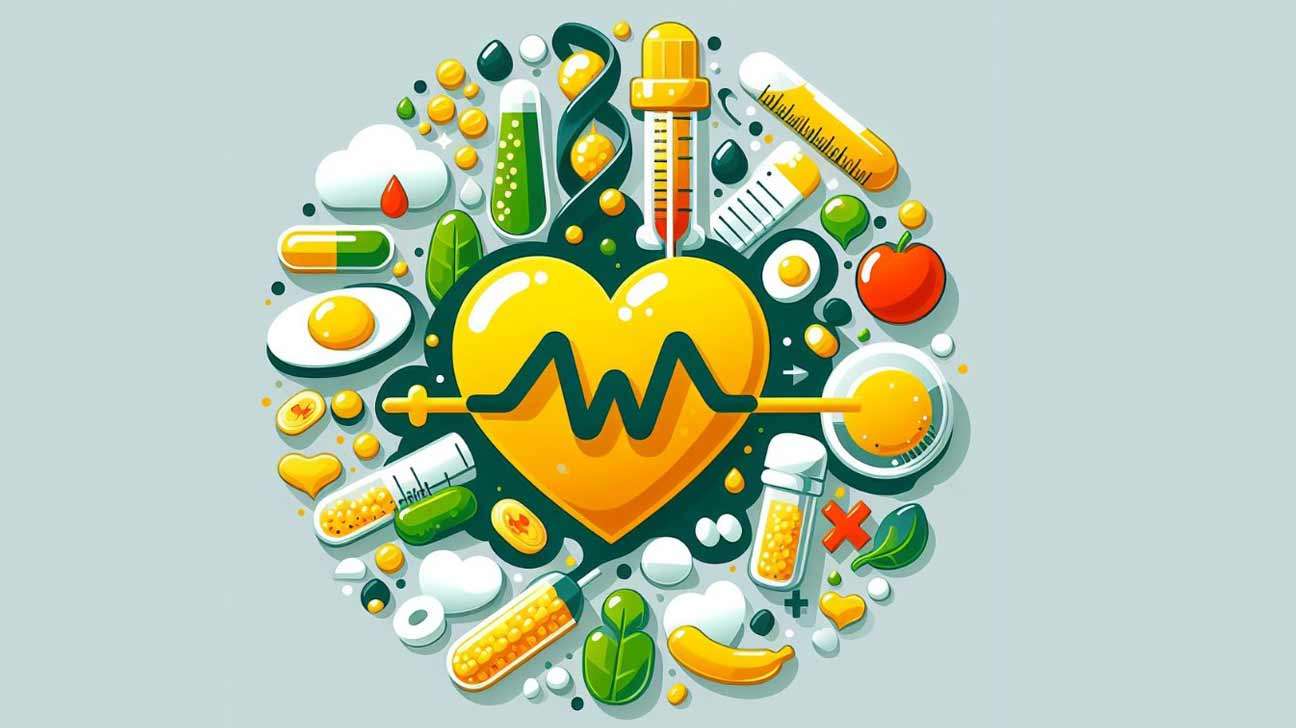High cholesterol is a common condition, often associated with cardiovascular diseases, but its relationship with other health problems, such as headaches, is less clear. While headaches are not generally considered a direct symptom of high cholesterol, recent research and evolving medical understanding suggest that there may be indirect links. This article will explore the possible connection between high cholesterol and headaches by examining cholesterol’s role in vascular health, its impact on circulation, and the risk factors that tie cholesterol to conditions that could lead to headaches.
Understanding Cholesterol: Types and Functions
Before delving into the relationship between cholesterol and headaches, it’s important to understand what cholesterol is and how it functions in the body. Cholesterol is a fatty substance found in the bloodstream and is essential for building cell membranes and producing hormones. It’s transported in the blood by two main types of lipoproteins:
- Low-Density Lipoprotein (LDL): Often referred to as “bad” cholesterol, LDL carries cholesterol from the liver to the cells. If there’s too much LDL in the blood, it can build up in the walls of the arteries, leading to plaque formation.
- High-Density Lipoprotein (HDL): Known as “good” cholesterol, HDL helps remove excess cholesterol from the bloodstream and transports it back to the liver, where it’s processed and eliminated from the body.
The balance between LDL and HDL cholesterol levels is critical. An excess of LDL cholesterol can lead to atherosclerosis, a condition in which the arteries become clogged and narrowed, increasing the risk of cardiovascular diseases.
The Role of Cholesterol in Vascular Health
High cholesterol primarily affects the vascular system, specifically through the buildup of plaque in the arteries. This condition, known as atherosclerosis, causes the arteries to stiffen and narrow, which can lead to reduced blood flow to various parts of the body. While the effects of high cholesterol are most commonly associated with heart disease and stroke, compromised blood flow can also affect other systems in the body, including the brain.
Atherosclerosis and Headaches
One of the most plausible connections between high cholesterol and headaches lies in the potential for impaired circulation. If arteries that supply blood to the brain become narrowed or blocked, the reduced blood flow could trigger headaches. These headaches are often related to vascular changes, where the blood vessels constrict and dilate, causing pain.
Moreover, atherosclerosis can lead to more serious conditions like transient ischemic attacks (TIAs) or strokes, both of which can manifest with headaches as an early symptom. In these cases, the headaches would be secondary to the underlying vascular issue caused by high cholesterol.
Types of Headaches Potentially Linked to High Cholesterol
There are several types of headaches that may have an indirect link to high cholesterol due to the role of vascular health. These include:
- Migraines: Migraines are complex headaches that involve vascular changes, and some studies suggest that people with high cholesterol may be more prone to migraines. The exact mechanisms are not fully understood, but it is believed that cholesterol-related vascular issues may contribute to the onset of migraines.
- Tension Headaches: Although tension headaches are typically linked to muscle strain and stress, poor circulation caused by high cholesterol might exacerbate these types of headaches. Reduced oxygen supply to muscles and tissues could contribute to pain and tension, especially in the head and neck area.
- Cluster Headaches: Cluster headaches are severe, one-sided headaches that occur in cycles or clusters. While the relationship between high cholesterol and cluster headaches is not well established, vascular issues may play a role, especially in people with pre-existing cardiovascular risk factors.
- Hypertension-Related Headaches: High cholesterol often goes hand in hand with hypertension (high blood pressure), which is a known cause of headaches. When blood pressure spikes, the pressure in the blood vessels can lead to headaches, particularly if high cholesterol is contributing to the thickening or narrowing of these vessels.
Cholesterol, Inflammation, and Headache Risk
Another factor that may link high cholesterol to headaches is inflammation. Cholesterol, particularly when it builds up in the arteries, is associated with increased inflammation. The body’s immune response to this buildup involves the release of various chemicals that can cause blood vessels to swell and tighten. This inflammation could lead to vascular headaches, especially in people who already have underlying inflammatory conditions.
The Inflammatory Response and Vascular Health
Inflammation plays a key role in atherosclerosis, and it’s one of the body’s defense mechanisms against injury to the arterial walls. However, chronic inflammation can have damaging effects, leading to the thickening and narrowing of arteries. This is significant because vascular headaches, such as migraines, are often triggered by inflammatory processes. Elevated cholesterol levels can worsen this inflammation, creating a vicious cycle that heightens the risk of vascular-related headaches.
Cholesterol Medications and Headaches
While high cholesterol may indirectly contribute to headaches, the treatment of high cholesterol, specifically through the use of statins, may also play a role in headache development. Statins are commonly prescribed to lower LDL cholesterol levels, and while generally well-tolerated, they can have side effects, including headaches.
Statin-Related Headaches
Some people who take statins report headaches as a side effect. The exact mechanism is not entirely clear, but it’s believed that the reduction of cholesterol levels and its effects on cell membranes and circulation might contribute to the onset of headaches. Additionally, statins can cause muscle pain and fatigue, which may trigger tension headaches.
Although statin-related headaches are not usually severe, they can be bothersome for some patients. It’s important to consult a healthcare provider if these side effects become problematic, as there may be alternative cholesterol-lowering medications or lifestyle adjustments that can be made.
Other Health Conditions That Link High Cholesterol and Headaches
Apart from vascular issues and inflammation, high cholesterol can increase the risk of other health conditions that are associated with headaches. These conditions include:
1. Hypertension
High cholesterol is a major risk factor for hypertension, which can cause headaches. When blood pressure rises due to arterial stiffness or plaque buildup, the increased pressure on the blood vessels in the brain can lead to head pain. Hypertension headaches are often described as a pulsating or throbbing sensation, and they tend to worsen with physical activity.
2. Stroke
High cholesterol increases the risk of stroke by contributing to the narrowing of arteries that supply blood to the brain. One of the warning signs of a stroke or a TIA is a sudden, severe headache. These headaches are often accompanied by other neurological symptoms, such as weakness on one side of the body, confusion, and vision problems. While not all people with high cholesterol will experience a stroke, those with significantly elevated levels are at a greater risk.
3. Sleep Apnea
There is some evidence to suggest a link between high cholesterol and obstructive sleep apnea (OSA), a condition in which breathing stops and starts during sleep. People with OSA are more likely to have elevated cholesterol levels, and they are also prone to experiencing headaches, particularly in the morning. The exact relationship between sleep apnea, cholesterol, and headaches is still under investigation, but it may involve reduced oxygen levels and increased inflammation.
Preventing Headaches by Managing Cholesterol
Given the potential links between high cholesterol and headaches, managing cholesterol levels can be an effective strategy in reducing the risk of headaches related to vascular issues and inflammation. Several lifestyle changes and medical interventions can help maintain healthy cholesterol levels:
1. Diet
A diet rich in fruits, vegetables, whole grains, and healthy fats (such as omega-3 fatty acids) can help lower LDL cholesterol and improve HDL cholesterol. Reducing the intake of saturated fats, trans fats, and cholesterol-laden foods is crucial in keeping cholesterol levels in check.
2. Exercise
Regular physical activity not only helps maintain a healthy weight but also improves circulation and increases HDL cholesterol, which helps remove excess LDL from the bloodstream.
3. Medications
For individuals with significantly elevated cholesterol levels, medications like statins or other lipid-lowering agents may be necessary. It’s important to work closely with a healthcare provider to find a treatment plan that effectively manages cholesterol without causing unwanted side effects, such as headaches.
4. Regular Checkups
Monitoring cholesterol levels through regular checkups allows for early detection and intervention. Keeping cholesterol levels in a healthy range can prevent the development of vascular conditions that may lead to headaches.
Conclusion
While high cholesterol may not directly cause headaches, it can contribute to conditions that are known to trigger head pain, particularly those related to vascular health and circulation. Atherosclerosis, hypertension, and inflammation, all linked to elevated cholesterol levels, can lead to headaches, especially in individuals with other cardiovascular risk factors.
Managing cholesterol through a healthy lifestyle and, when necessary, medication can not only reduce the risk of heart disease and stroke but may also help in preventing headaches associated with these conditions. Understanding the complex relationship between cholesterol and vascular health underscores the importance of maintaining healthy cholesterol levels to protect overall well-being, including reducing the risk of headache development.
In conclusion, while the connection between high cholesterol and headaches is not direct, the indirect pathways through vascular changes, inflammation, and associated health conditions like hypertension and stroke suggest that keeping cholesterol levels under control is essential for preventing not just cardiovascular disease, but potentially headaches as well.

What Is High Cholesterol
Cholesterol is a fatty substance that is essential for building cells and producing certain hormones. It is carried through the bloodstream in lipoproteins, which are particles made up of fat and protein. There are two main types of cholesterol:
- Low-Density Lipoprotein (LDL): Often referred to as “bad” cholesterol, LDL carries cholesterol from the liver to the cells. If too much is delivered, it can build up in the walls of the arteries, leading to atherosclerosis (hardening and narrowing of the arteries).
- High-Density Lipoprotein (HDL): Known as “good” cholesterol, HDL carries cholesterol away from the cells and back to the liver, where it is either broken down or passed out of the body as a waste product.
- High cholesterol, or hypercholesterolemia, occurs when there is an elevated level of cholesterol in the blood. Specifically, high levels of LDL cholesterol or low levels of HDL cholesterol, or a combination of both, can increase the risk of developing cardiovascular diseases such as heart disease and stroke.
- A healthy balance of LDL and HDL cholesterol is essential for maintaining cardiovascular health. High cholesterol often does not cause noticeable symptoms, so it is important to monitor cholesterol levels through blood tests. Lifestyle factors such as diet, exercise, and overall health play a significant role in cholesterol levels, and management may involve lifestyle changes, medications, or a combination of both.
- It’s worth noting that while cholesterol is necessary for various bodily functions, an excess, particularly of LDL cholesterol, can contribute to the formation of plaques in the arteries, reducing blood flow and increasing the risk of heart-related issues. Regular check-ups and discussions with healthcare professionals are important for understanding and managing cholesterol levels.
Symptoms of High Cholesterol
Although high cholesterol doesn’t always have evident symptoms, it can be a contributing factor to several health conditions that can have symptoms. The following are some possible signs of high cholesterol and related health problems:
- Angina or Chest Pain: High cholesterol can lead to the buildup of plaque in the arteries, restricting blood flow to the heart and causing chest pain.
- Heart Attack: If a cholesterol plaque ruptures and triggers a blood clot, it can block an artery, leading to a heart attack. Symptoms may include chest pain, shortness of breath, and discomfort in the upper body.
- Stroke: Similar to a heart attack, a cholesterol-related blood clot can block an artery to the brain, causing a stroke. Symptoms may include sudden numbness, weakness, confusion, and difficulty speaking.
- Peripheral Artery Disease (PAD): Cholesterol buildup in the arteries supplying the legs and feet can cause PAD, leading to pain or numbness in the extremities, especially during physical activity.
- Xanthomas: These are fatty deposits that can form under the skin, often around the eyes, indicating high cholesterol levels.
- Tendinous xanthomas: These are cholesterol deposits that accumulate in tendons, causing lumps or bumps under the skin.
- Yellowish Patches on Skin: High cholesterol may contribute to the development of yellowish patches or bumps on the skin, known as xanthelasma.
- Gallstones: High levels of cholesterol in the bile can contribute to the formation of gallstones, leading to abdominal pain and discomfort.
It’s important to note that many people with high cholesterol may not experience noticeable symptoms until a more severe health issue, such as a heart attack or stroke, occurs. Regular cholesterol screenings and check-ups with healthcare professionals are crucial for early detection and management. Lifestyle changes, dietary modifications, and, if necessary, medication can help control high cholesterol levels and reduce the risk of associated health problems. Always consult with a healthcare professional for personalized advice and treatment.
Causes of High Cholesterol
High cholesterol can result from a combination of genetic, lifestyle, and health factors. Here are some common causes of high cholesterol:
- Poor Diet: Diets high in saturated and trans fats, found in red meat, full-fat dairy products, and processed foods, can contribute to elevated cholesterol levels.
- Lack of Exercise: Physical inactivity can lead to weight gain and higher levels of low-density lipoprotein (LDL or “bad” cholesterol) while reducing high-density lipoprotein (HDL or “good” cholesterol).
- Obesity: Being overweight or obese can increase LDL cholesterol and decrease HDL cholesterol.
- Genetics/Family History: High cholesterol can be inherited. If family members have a history of high cholesterol or heart disease, there may be a genetic predisposition.
- Age and Gender: Cholesterol levels tend to rise with age. Women generally have lower cholesterol levels than men before menopause but may see an increase after menopause.
- Smoking: Tobacco smoke contains chemicals that can lower HDL cholesterol and damage blood vessel walls, making it easier for cholesterol to accumulate.
- Diabetes: People with diabetes often have higher triglyceride levels and lower HDL cholesterol levels, contributing to an increased risk of high cholesterol.
- Certain Medical Conditions: Hypothyroidism, kidney disease, and liver diseases can affect how the body processes cholesterol.
- Medications: Some medications, such as certain diuretics, beta-blockers, and corticosteroids, may contribute to higher cholesterol levels.
- Excessive Alcohol Consumption: Drinking too much alcohol can lead to higher levels of triglycerides, a type of fat in the blood, contributing to elevated cholesterol levels.
- Stress: Chronic stress may indirectly contribute to high cholesterol levels through unhealthy coping mechanisms, such as poor dietary choices and lack of exercise.
What Is LDL & HDL?
LDL and HDL are two types of lipoproteins, which are particles that carry cholesterol through the bloodstream.
LDL (Low-Density Lipoprotein):
- Nickname: Often referred to as “bad” cholesterol.
- Function: LDL carries cholesterol from the liver to the cells throughout the body.
- Concern: If there is an excess of LDL cholesterol in the bloodstream, it can lead to the accumulation of cholesterol in the walls of arteries. This can contribute to the formation of plaques, which may narrow and block arteries, increasing the risk of atherosclerosis and cardiovascular diseases, such as heart attacks and strokes.
HDL (High-Density Lipoprotein):
- Nickname: Often referred to as “good” cholesterol.
- Function: HDL carries cholesterol away from the cells and transports it back to the liver, where it can be either broken down or passed out of the body as a waste product.
- Benefit: High levels of HDL are associated with a lower risk of cardiovascular diseases. HDL helps remove excess cholesterol from the bloodstream, reducing the likelihood of plaque formation in the arteries.
LDL and HDL play crucial roles in cholesterol metabolism. While LDL delivers cholesterol to cells and tissues, high levels can contribute to health issues. HDL, on the other hand, helps remove excess cholesterol from the bloodstream, providing a protective effect against cardiovascular diseases. Maintaining a healthy balance between LDL and HDL cholesterol is essential for cardiovascular health. Lifestyle factors, including diet, exercise, and overall health, can influence the levels of these lipoproteins. Regular monitoring and discussions with healthcare professionals can guide efforts to manage cholesterol levels effectively.

How to Check High Cholesterol Level ?
Checking cholesterol levels typically involves a blood test, known as a lipid panel or cholesterol blood test. Here’s how you can check your cholesterol levels:
Consult with a Healthcare Professional:
Schedule an appointment with your healthcare provider to discuss your concerns about cholesterol and assess your overall health.
Fasting Before the Test:
Many cholesterol tests require fasting for 9-12 hours before the blood sample is taken. Your healthcare provider will inform you if fasting is necessary.
Blood Test:
During the appointment, a healthcare professional will take a blood sample, usually from a vein in your arm. The blood sample is sent to a laboratory for analysis.
Lipid Panel Results:
- Total Cholesterol: The overall amount of cholesterol in your blood.
- Low-Density Lipoprotein (LDL) Cholesterol: Often referred to as “bad” cholesterol, high levels can contribute to plaque buildup in arteries.
- High-Density Lipoprotein (HDL) Cholesterol: Often referred to as “good” cholesterol, higher levels are considered beneficial as HDL helps remove LDL from the bloodstream.
- Triglycerides: A type of fat in the blood that, when elevated, can contribute to heart disease.
Interpretation:
Your healthcare provider will interpret the results and discuss whether your cholesterol levels are within a healthy range or if any action is needed.
Follow-Up and Recommendations:
Based on the results, your healthcare provider may recommend lifestyle changes, dietary modifications, increased physical activity, or, in some cases, medication to manage cholesterol levels.
- It’s essential to note that cholesterol guidelines may vary based on individual health factors, age, and other conditions. Regular cholesterol screenings, especially for individuals at risk or with a family history of heart disease, are crucial for early detection and effective management.
- Always consult with a healthcare professional to determine the most appropriate testing schedule and receive personalized advice based on your health status.
Foods to Avoid with High Cholesterol
If you have high cholesterol levels, it’s important to be mindful of your diet to help manage your condition and reduce the risk of heart disease. Here are some foods to avoid or limit if you have high cholesterol:
- Red meat
- Full-fat dairy products
- Processed and fried foods
- Margarine and partially hydrogenated oils
- Organ meats (liver, kidney)
- Shellfish (shrimp, lobster, crab)
- Processed Foods
- Fast Food
- Fried Foods
- Egg Yolks
- Full-Fat Dairy
- Baked Goods and Snacks
- Certain Cooking Oils
- High-Sugar Foods
It’s important to focus on a heart-healthy diet that includes:
- Choose Healthy Fats
- Omega-3 Fatty Acids
- Fiber-Rich Foods
- Fruits and Vegetables
- Whole Grains
- Lean Proteins
- Limit Processed Foods
- Portion Control
- Plant Sterols and Stanols
- Limit Added Sugars
- Stay Hydrated
- Limit Alcohol Intake
It’s crucial to note that these dietary recommendations should be combined with a healthy lifestyle, including regular physical activity and avoiding smoking, to effectively manage cholesterol levels. Before making significant changes to your diet, it’s advisable to consult with a healthcare professional or a registered dietitian for personalized advice based on your specific health needs.

Medication & Treatment
When lifestyle changes alone are not sufficient to manage high cholesterol, healthcare professionals may recommend medications to help lower cholesterol levels. There are several classes of medications commonly used for this purpose:
Statins:
Statins are one of the most commonly prescribed medications for lowering cholesterol. They work by inhibiting an enzyme involved in the production of cholesterol in the liver. Examples include atorvastatin, simvastatin, and rosuvastatin.
Ezetimibe:
Ezetimibe is a medication that reduces the absorption of cholesterol from the digestive tract. It is often prescribed in combination with statins.
PCSK9 Inhibitors:
PCSK9 inhibitors are a newer class of medications that work by increasing the liver’s ability to remove LDL (bad) cholesterol from the blood. These drugs are typically reserved for individuals who do not adequately respond to statins or cannot tolerate them.
Bile Acid Sequestrants:
Bile acid sequestrants bind to bile acids in the digestive system, preventing their reabsorption. This process helps the body use cholesterol to make more bile acids, ultimately lowering cholesterol levels. Examples include cholestyramine and colesevelam.
Fibrates:
Fibrates can lower triglyceride levels and increase HDL (good) cholesterol. They are often used in combination with statins. Examples include fenofibrate and gemfibrozil.
Niacin (Vitamin B3):
Niacin is a B-vitamin that can help increase HDL cholesterol and lower triglycerides. It is available both over-the-counter and as a prescription.
Combination Medications:
Some medications combine different classes of drugs to provide a more comprehensive approach to cholesterol management. For example, a combination of a statin and ezetimibe is available.
- It’s important to note that medication decisions are individualized based on a person’s overall health, cholesterol levels, and potential side effects. Regular monitoring and follow-up with a healthcare professional are essential to ensure the effectiveness and safety of the chosen treatment.
- In addition to medications, lifestyle modifications such as a heart-healthy diet, regular exercise, maintaining a healthy weight, and not smoking are crucial components of cholesterol management. Always consult with a healthcare provider to determine the most appropriate treatment plan for your specific situation.
High Cholesterol Self-Care Diet Plan
Managing high cholesterol through self-care and a heart-healthy diet is an essential component of overall cardiovascular health. Here’s a sample diet plan that incorporates foods known to help lower cholesterol levels:
Breakfast:
- Oatmeal topped with fresh berries and a sprinkle of chia seeds.
- Whole grain toast with avocado or a small amount of nut butter.
- Green tea or black coffee.
Mid-Morning Snack:
- A small handful of unsalted nuts (almonds, walnuts, or pistachios).
- A piece of fruit (apple, pear, or berries).
Lunch:
- Grilled or baked salmon or trout (rich in omega-3 fatty acids).
- Quinoa or brown rice.
- Steamed or roasted vegetables (broccoli, Brussels sprouts, carrots).
- A side salad with dark leafy greens and a vinaigrette dressing.
Afternoon Snack:
- Greek yogurt with a drizzle of honey and a handful of fresh berries.
- Carrot sticks or cucumber slices with hummus.
Dinner:
- Baked or grilled skinless chicken breast or tofu.
- Sweet potatoes or whole grain pasta.
- Sautéed spinach or kale with garlic.
- A side of legumes, such as lentils or chickpeas.
Evening Snack (if needed):
- Air-popped popcorn seasoned with a dash of olive oil and herbs.
- Herbal tea.
Remember to consult with a healthcare professional or a registered dietitian before making significant changes to your diet, especially if you have underlying health conditions or are taking medications. They can provide personalized advice based on your specific health needs. Additionally, regular exercise and other lifestyle factors also play a crucial role in managing cholesterol levels.



